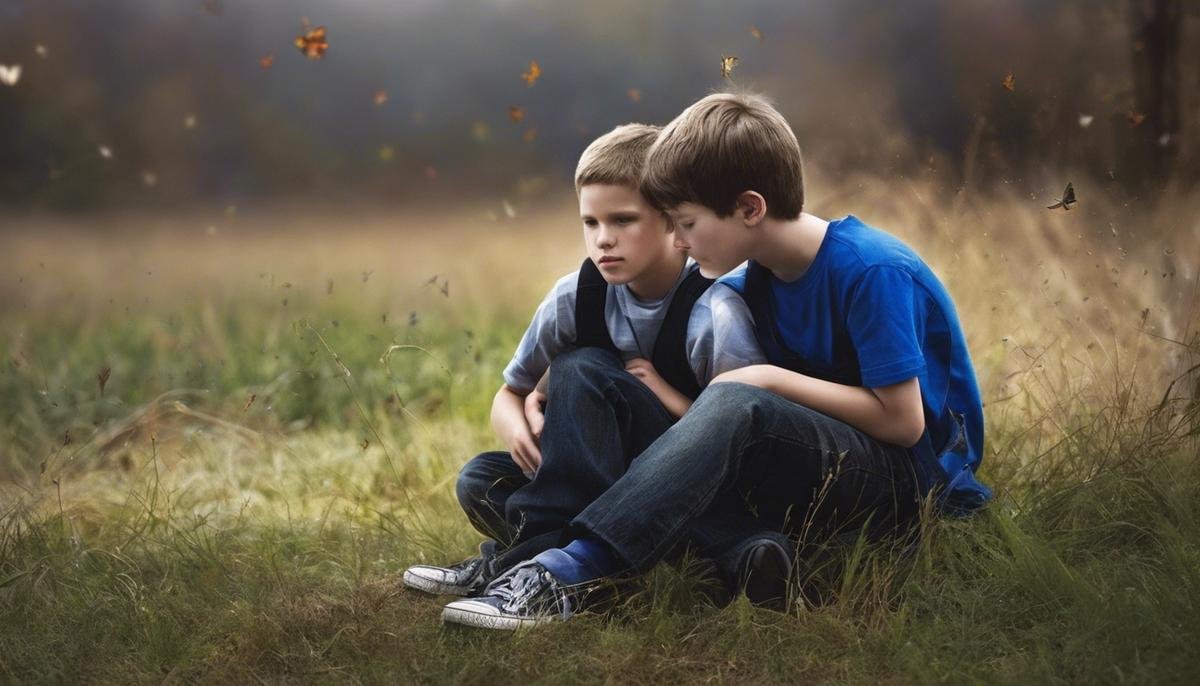
Autism, a complex developmental disorder that affects one’s social interaction and communication, marks a unique journey for each individual it touches. However, these uniqueness can also increase their vulnerability to bullying, accentuating the challenges they face each day. A nuanced understanding of autism is consequently a powerful tool, enlightening families, educators, and the larger society towards a more empathetic perspective. This exploration commences with a comprehensive overview of autism, aiming to shed light on its diverse manifestations, symptoms, diagnosis, and treatments. By delving further, we seek to unravel the critical intersection between autism and bullying – dissecting the reasons behind their susceptibility, the environments conducive to bullying, and the consequential impact on their overall well-being. Additionally, children spend a significant proportion of their day in school, making it an integral part of this discussion.
Understanding Autism
Title: Embracing the Journey: Understanding Autism’s Impact on Families
As those deeply embedded in the wonderful journey that is parenthood, it is quite common for one to seek understanding and empathy about experiences outside our personal realm. This is especially true when it comes to understanding Autism and its significance within a family dynamic. Encountering Autism in our circles, whether it be in our homes or in our communities, calls for an in-depth understanding and a heart brimming with compassion.
Firstly, it’s imperative to comprehend that Autism Spectrum Disorder (ASD) is not a one-size-fits-all definition. It’s often called a “spectrum” disorder because the symptoms and characteristics can present themselves in a myriad of ways, from mild to severe. These variations can impact social skills, communication, relationships, and self-regulation. It’s much like an ice cream sundae – no two are the same!
With a family member diagnosed with Autism, some transformation within family dynamics is inevitable. There will be an adjustment period as the family learns to navigate around these new grounds, but just like any other life situation, it’s about learning and growing together. Understanding and accepting these changes are golden steps towards building an inclusive environment at home.
Ensure open lines of communication for a smoother transition and overcoming any hurdles. Discussing, reassuring, and educating all family members, including siblings, about Autism can help eliminate any misconceptions and encourage a supportive atmosphere. Remember: knowledge is a powerful tool against uncertainty and fear.
Schooling and education for children with ASD is also a pivotal part of the journey. It’s crucial to explore different educational settings to find one that suits your child’s needs best. Would they strive better in a public school with special education services, or are they more comfortable in a school specializing in Autism? These are decisions that will need patience, research, and a lot of heart.
We can’t have a discussion about the impact of Autism on a family without acknowledging the financial aspect. From special education to medical care, to therapy sessions – the costs can quickly add up. It’s important to know help is out there, through both federal and state programs, along with various Autism-specific organizations.
Above all, it’s necessary to remember that every child is unique, with their own set of strengths and weaknesses. Just as with any child, a kid with Autism brings joy, laughter, and a world of discovery for their family. Treasuring these moments and celebrating every little achievement paves the way for a fulfilling family life.
Understanding Autism, in essence, doesn’t just mean understanding a list of symptoms or traits. It’s about embracing the journey, recognizing the challenges, appreciating the victories, and fostering an atmosphere of acceptance and love. Every family journey is beautiful, filled with shared laughter, tender moments and love. Embrace the journey, for it’s these experiences that truly make a family, a home.

The Intersection Between Autism and Bullying
Understanding The Connection Between Autism and Bullying
Despite the growing awareness and generally rising acceptance of Autism Spectrum Disorder (ASD) in society, there’s an unfortunate reality that tends to go unnoticed: the increased risk of being bullied that children with ASD commonly face. This eye-opening issue is one that families, educators, and communities need to understand more intensely in order to create a safer, more inclusive environment for all children.
Autism presents itself in a myriad of forms, with each child having a unique set of characteristics and behaviors. These differences, however, are often seen as a reason for ridicule among peers, leading to the targeting of children with ASD. These children are almost three times more likely to be bullied due to difficulties with social interaction and the ability to read social cues, which are common characteristics of autism.
Further, individuals with autism often have unique interests that may not align with what’s generally accepted or liked by their peers. This mismatch can lead to a lack of friendship and misunderstanding, causing children with ASD to be singled out even more. This can lead to isolation, and in some cases, it can contribute to the likelihood of being bullied.
Moreover, the cognitive development of children with ASD also plays a substantial role in them being the target of bullying. Children with autism can sometimes struggle to understand sarcasm, jokes, or deception, which can results in further social exclusion and unintentionally encourage bullying behavior among their peers.
It’s essential to note that in many cases, children don’t recognize what they’re experiencing as bullying, particularly if their understanding of social norms and cues is limited. Coupled with a difficulty in verbal communication found in some individuals with ASD, this can lead to major hurdles in reporting bullying incidents, leaving them underreported and untreated.
Within the schooling environment, where children spend a significant portion of their day, teachers and administrators need to play a more active and crucial role in preventing bullying. Schools must foster an environment that respects differences and promotes understanding. This strategy includes educating all students about ASD and its various facets, and implementing a zero-tolerance policy for any bullying activities, regardless of the child’s abilities or conditions.
It’s a collective responsibility— of the parents, schools, and society— to ensure the safety and inclusivity for children with ASD. With a better understanding of autism and more resources dedicated to educating the public, society can begin to limit the frequency and severity of bullying incidents involving children with ASD.
Every child with autism is immensely special, with a distinct set of qualities and capabilities that make them beautifully unique. By embracing and promoting this diversity, everyone can help create a nurturing, accepting, and bully-free environment for children with ASD, where they can progress, thrive and lead fulfilling lives.

Autism, Bullying and the Role of Schools
Understanding the Role of Schools in the Autism-Bullying Dynamic
Schools hold a pivotal role in the autism and bullying equation. As the wellspring of a child’s social foundations and often witness to their utmost vulnerability, schools have the potential to adeptly manage this dynamic — or conversely, contribute to it. Let’s take a magnifying glass to explore this further.
First and foremost, schools serve primarily as a place for learning — but not just in terms of academics. Schools act as mini-societies, where children first learn social norms, behaviors, and importantly, acceptable ways to interact with peers who may be different from them. For children with Autism Spectrum Disorder (ASD), this can be a challenging landscape.
Being unable to comply with these unwritten norms due to their neurological differences, children with ASD can often find themselves subjected to bullying. Some students may find the behaviors of their classmates with ASD to be peculiar, which can lead to curiosity and, regrettably, sometimes even mean-spirited discrimination.
Thus, schools play the role of broadcasting the first communicative signals about bullying and autism. If left unchecked, they can inadvertently become places where children learn not only their ABC’s and 123’s, but also harmful behaviors such as discrimination and exclusion.
Yet, schools can also serve as protective shields and safe havens for children with ASD. We hear about brave examples every day of resourceful educators making a difference. Teachers who incorporate lessons about ASD in their curriculum, students who are encouraged to understand and befriend their peers with unique needs, and protocols to prevent as well as immediately address bullying, are some of the ways schools are effecting a constructive change.
But herein lies the crux — the reaction of schools to the autism-bullying dynamic ebbs and flows on the world’s unspoken attitudes towards autism. Schools, in their microcosmic form, reflect our society. If we as communities, households, educate ourselves about ASD, foster understanding and acceptance, and sternly frown upon discrimination — it is these attitudes that will eventually permeate the schooling system.
Therefore, the spotlight here should not be on how schools contribute to the autism-bullying dynamic, but HOW they can revolutionize their responses to manage it better. Schools, undeniably, are under immense pressure catering to the emotional and cognitive well-being of every student. Providing specialized programs to address the needs of students with ASD, training teachers for better awareness of ASD, involving the community to foster understanding and acceptance, and initiating prompt anti-bullying measures are just some avenues to navigate this situation most productively.
In conclusion, schools definitely play a role in the autism-bullying dynamic. But it is a broader, collective responsibility we share – as parents, educators, volunteers, and simply as human beings – to shift our society’s archaic mindset. Instead of just preparing children with ASD to manage the world, the focus needs to be on preparing the world to warmly welcome individuals with ASD. Schools, with their trusted influence, can be pivotal leaders in this sea-change.

Protecting Autistic Children from Bullying
Transitioning to practical strategies to protect children with Autism Spectrum Disorder (ASD) from bullying, it’s essential to recognize the role of active parenting. Being engaged and proactive can make a world of difference in a child’s life. Like a sown seed needing sunlight, water, and care, children with ASD need parents to be their leading advocates. Supporting a child in a world that might not fully understand or accept their differences can be challenging, but parents are armed with determination, love, and an arsenal of practical strategies.
One of the most effective strategies is fostering a strong connection with the child. Though children with ASD might find it difficult to express emotions in conventional ways, their hearts beat with the same love and desire for comfort. Everyday routines like bedtime stories, shared meals, and game nights provide opportunities for deepening bonds. Creating a strong support network will help a child feel loved and protected, and even the smallest victories celebrated together can boost their confidence.
Engaging in open discussions about bullying is equally important. It lays groundwork for children with ASD to understand that unfair treatment is unacceptable. A protective bubble isn’t always feasible, so equipping them with the knowledge about what constitutes as bullying and how to seek help is crucial. Use stories, illustrations, or situations from their favorite TV shows to explain complex scenarios in simple terms they can understand.
Social skill development can also serve as a shield against bullying. Children with ASD often find interpreting social cues challenging, resulting in alienation or misunderstanding. It’s where parents can step in, and through role-playing games or real-life situations, help them understand and harness social dynamics.
Further, it is important to develop trusting relationships with the school staff. School is where children spend most of their time, making the school environment pivotal in protecting children from potential bullying. Frequent communication allows parents and teachers to nip any unfair treatment in the bud before a child’s self-esteem gets affected.
The power of community outreach shouldn’t be underestimated either. Participating in local events, autism awareness programs, or even arranging small meetings with neighborhood parents can sow the seeds of understanding and acceptance. It’s an opportunity to dispel myths about ASD, shed light on the unique characteristics and strengths of children with ASD, and create a supportive environment that discourages bullying.
Advocacy for children with ASD also extends to pushing for legislative changes. Parents can voice out their concerns and experiences to local representatives and advocate for comprehensive laws for preventing and addressing bullying against children with ASD.
While these strategies require time and effort, the joy of seeing children with ASD navigate the world with their heads held high is priceless. Each day is a new chapter in their journey, and as parents, the privilege lies in championing their cause, protecting them from harm, and ushering in a society where acceptance stands taller than discrimination.

Navigating the terrain of bullying incidents involving children with autism presents a daunting task for families and educators alike. It requires fostering an open line of communication, empowering children with the ability to self-advocate, providing teacher training in special needs education, and above all, adopting a zero-tolerance policy towards bullying in schools. The broader community is not left out; raising awareness about bullying and its drastic impact on autistic children should remain a communal responsibility. With a collective effort, it is entirely possible to build a nurturing and inclusive environment where every child, irrespective of their unique abilities, can thrive. As we continue to strive towards this vision, we create a world that doesn’t just see the autism but acknowledges and celebrates the child.




